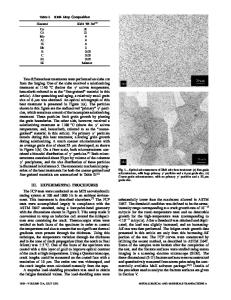Inclusion size effect on the fatigue crack propagation mechanism and fracture mechanics of a superalloy
- PDF / 1,683,371 Bytes
- 8 Pages / 630 x 792 pts Page_size
- 3 Downloads / 482 Views
I.
INTRODUCTION
T H E cleanliness of nickel-base superalloys is important, because their fatigue and fracture mechanics properties can be strongly affected by the ceramic and metal-reaction inclusions introduced during the primary melt process, tl] It is widely believed that the low cycle fatigue life of nickel-base superalloys is greatly increased as a consequence of inclusion reduction in the melt process. Electron beam cold hearth remelting (EBCHR) is a recently developed technique that offers the most dramatic improvements in the cleanliness of superalloys. The electrodes are charged into a high vacuum chamber and are subsequently melted by an array of electron beams. Molten metal drips into a horizontal water-cooled copper hearth until the hearth is full and the molten metal overflows the pour lip into a withdrawal casting mold (Figure 1). Electron beams are rastered to keep metal in the hearth molten, allowing for light oxides and nitrides to float to the surface or heavy particles to sink into the skull. It is estimated that an excess of 95 pct of oxide particles 25 /zm or larger can surface in 3 minutes. Once floating on the very tranquil surface, a water-cooled copper skimmer can efficiently prevent the floating inclusions from flowing over the pour lip. t21 Figure 2(a) shows the S-N curves obtained from low cycle fatigue tests on ASTM 10 grain-size vacuum induction melted IN718 and vacuum induction melted and electron beam cold hearth remelted IN718. Figure 2(b) shows the S-N curves for ASTM 8 grain-size materials. These data illustrate the statistical difference in low cycle fatigue life of clean and dirty superalloys. Alloy IN718 is the most widely used wrought superalloy in jet engines today. TAKESHI DENDA, Visiting Scholar from Nippon Mining Company, Tokyo, Japan, PETER L. BRETZ, Graduate Research Assistant, and JOHN K. TIEN, Engineering Regents Chair Holder and Director, are with The Strategic Materials R&D Laboratory, The University of Texas at Austin, Austin, TX 78712-1063. Manuscript submitted February 27, 1991. METALLURGICAL TRANSACTIONS A
However, the functional dependence between fracture characteristics and inclusions requires further study, and the mechanism for the improvement needs to be elucidated. In this study, the propagation mechanism of low cycle fatigue cracks initiated from inclusions near the surface is examined in the low cycle fatigue tests of finegrained IN718. II.
TEST MATERIAL
The materials used in this study were vacuum induction melted IN718 (VIM 718), vacuum induction melted and electron beam cold hearth remelted IN718 (VIM-EBCHR 718), and vacuum induction melted and vacuum arc remelted IN718 (VIM-VAR 718). The VIM 718 and the primary vacuum induction melted barstock of VIM-EBCHR 718 were taken from the same heat. The VIM-VAR 718 was a commercial jet engine grade superalloy prepared separately from VIM 718 and VIM-EBCHR 718. The pancake forged materials underwent the following direct aging heat treatments to develop a duplex distribution of very fine 7' and 3/' strengt
Data Loading...











